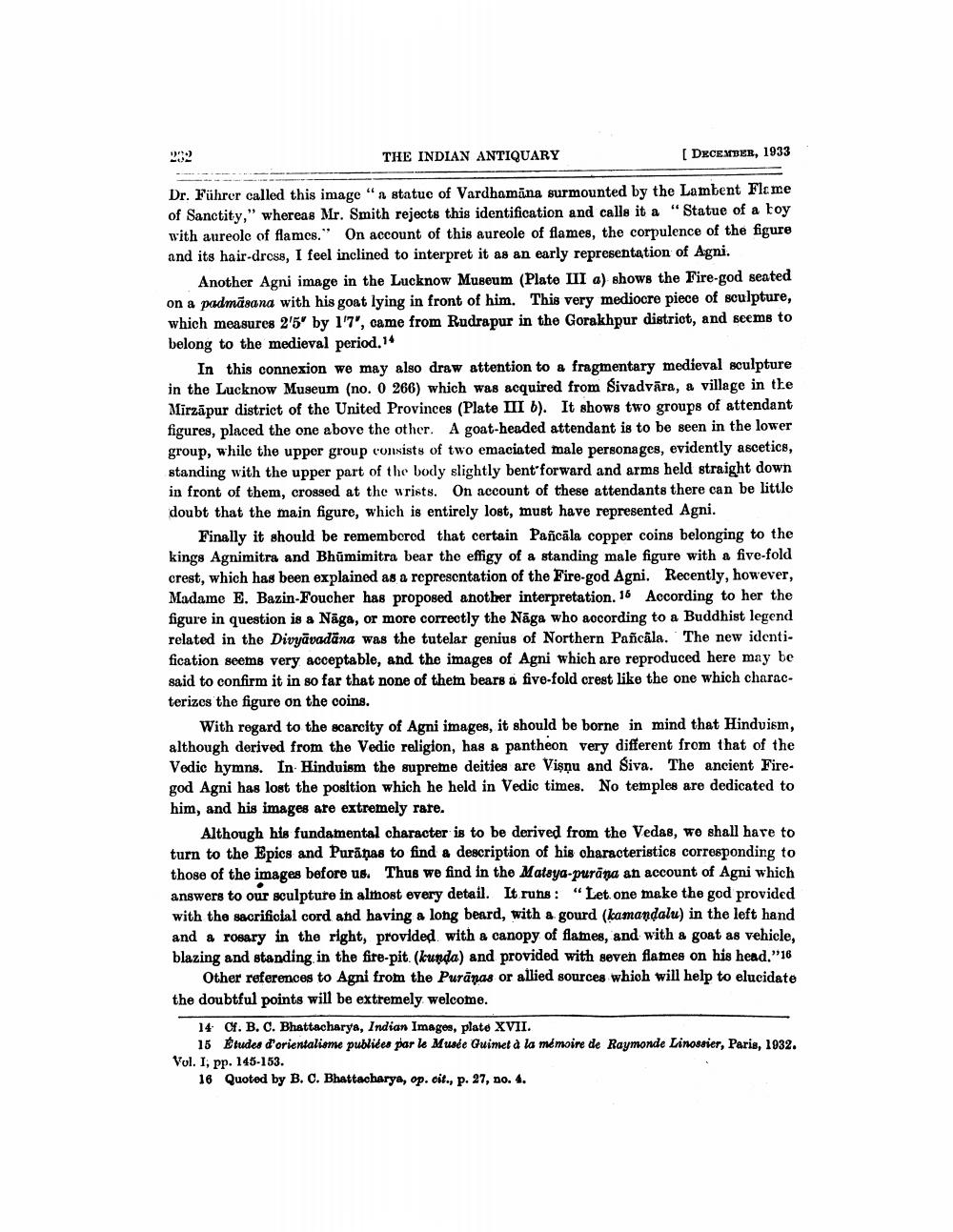________________
THE INDIAN ANTIQUARY
[ DECEMBER, 1933
Dr. Führer called this image "a statue of Vardhamana surmounted by the Lambent Flc me of Sanctity," whereas Mr. Smith rejects this identification and calls it a "Statue of a boy with aureole of flames." On account of this aureole of flames, the corpulence of the figure and its hair-dross, I feel inclined to interpret it as an early representation of Agni.
Another Agni image in the Lucknow Museum (Plate III a) shows the Tire-god seated on a padmāsana with his goat lying in front of him. This very mediocre piece of sculpture, which measures 2'5' by 1'7", oame from Rudrapur in the Gorakhpur district, and seems to belong to the medieval period. 1*
In this connexion we may also draw attention to a fragmentary medieval sculpture in the Lucknow Museum (no. O 266) which was acquired from Sivadvāra, a village in the Mirzāpur district of the United Provinces (Plate III b). It shows two groups of attendant figures, placed the one above the other. A goat-headed attendant is to be seen in the lower group, while the upper group consists of two emaciated male personages, evidently ascetics, standing with the upper part of the body slightly bent forward and arms held straight down in front of them, crossed at the wrists. On account of these attendants there can be little doubt that the main figure, which is entirely lost, must have represented Agni.
Finally it should be remembered that certain Pancala copper coins belonging to the kings Agnimitra and Bhūmimitra bear the effigy of a standing male figure with a five-fold crest, which has been explained as a representation of the Fire-god Agni. Recently, however, Madame E. Bazin-Foucher has proposed another interpretation. 16 According to her the figure in question is a Näga, or more correctly the Nāga who according to a Buddhist legend related in the Divyāvadāna was the tutelar genius of Northern Pañcāla. The new identification seems very acceptable, and the images of Agni which are reproduced here may be said to confirm it in so far that none of them bears a five-fold crest like the one which characterizes the figure on the coins.
With regard to the scarcity of Agni images, it should be borne in mind that Hinduism, although derived from the Vedio religion, has & pantheon very different from that of the Vedic hymns. In Hinduism the supreme deities are Vişņu and Siva. The ancient Firegod Agni has lost the position which he held in Vedic times. No temples are dedicated to him, and his images are extremely rare.
Although his fundamental character is to be derived from the Vedas, wo shall have to turn to the Epics and Puranas to find a description of his characteristics corresponding to those of the images before us. Thus we find in the Matsya-purāna an account of Agni which answers to our sculpture in almost every detail. It runs: "Let one make the god provided with the sacrificial cord and having a long beard, with a gourd (kamandalu) in the left hand and a rosary in the right, provided with a canopy of flames, and with a goat as vehicle, blazing and standing in the fire-pit (kunda) and provided with seven flames on his head."'16
Other references to Agni from the Puranas or allied sources which will help to elucidate the doubtful points will be extremely welcome.
14 C4. B. C. Bhattacharya, Indian Images, plato XVII.
15 Etudes d'orientalisme publiées par le Musée Guimet à la mémoire de Raymonde Linossier, Paris, 1932. Vol. I, pp. 145-153.
16 Quoted by B. C. Bhattacharya, op. cit., p. 27, no. 4.




